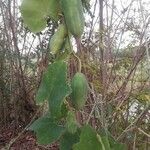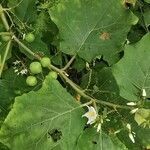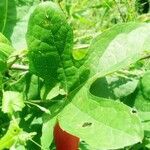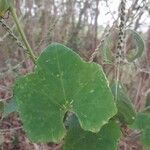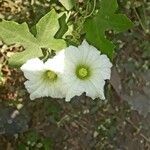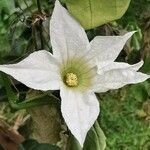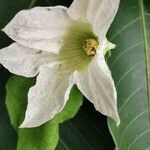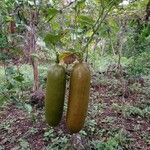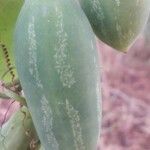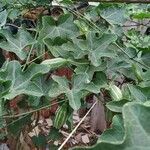Herbaceous or soft-woody climbers to 8 m long, sparsely puberulous, early glabrescent; older stem to 20 mm across, with grey bark. Probract fleshy, elliptic to oblong, 2-3 mm long, caducous. Tendrils unbranched. Leaves: petiole 1-2.5 cm long; blade slightly succulent, unlobed, (3-or) 5-angular or (deeply) 3-5(-7)-lobed, or dissected to 4/5 deep, 3-10 cm across, glands small, several, near the insertion of the petiole and along lateral veins, cystoliths in older leaves present, margin minutely (blackish) dentate-sinuate, apex acute or rounded. Male flowers solitary (or 2 or 3); pedicel 20-50 mm long; receptacle-tube greenish white, cup-shaped, narrowed to the base, 6-8 by c. 6 mm at throat; sepals oblong-subulate, c. 3 mm long, ± up-curved; corolla white, pale green veined, broad campanulate, (15-)25-30 mm long, inside (sparsely) pubescent, lobes ovate-oblong, acute(-acuminate); stamens inserted c. 5 mm below the throat of the receptacle-tube, filaments either connate or free but coherent, forming a hollow column (4-)5-6 mm long (sometimes leaving 3 openings at base), synandrium c. 5 mm diam.; the receptacle-tube below the insertion of the stamens densely white-hairy, hiding a basal cavity, c. 3 mm deep, comprising a conspicuous green-yellow cup-shaped disc adnate to the base of the tube. Female flowers: pedicel 1-3 cm long; ovary oblong, 10(-13) by 2(-3) mm, narrowed at both ends, style 3-5 mm long, at base surrounded by a cup-shaped disc, stigmas 3, usually 2-lobed, 5-7 mm long, papillose; staminodes 3, minute. Fruit green-white blotched, ripening red (starting at the apex), (narrowly) ellipsoid, 2.5-6 by 1.5-3 cm, apex subacute, pulp red, juicy; fruiting pedicel 1-4 cm long. Seeds 6-7 by 2.5-3 by c. 1.5 mm, ± smooth, margin narrow.
Dioecious perennial with tuberous rootstock. Tendrils simple. Probract 1–2 mm long. Leaves variable, ovate to orbicular, cordate at base; lamina 3–10 cm long, 4–10 cm wide, 5-angled to palmately 3–5-lobed; lobes shallow to deep and lobulate, minutely dentate, obtuse, mucronate, glabrescent above, hispid beneath, with 3–8 glands near attachment of petiole and major nerve branchings; petiole 1–3 cm long. Male flowers solitary, rarely in fascicles of 2 or 3; pedicels 15–50 mm long; hypanthium 7–12 mm long; calyx-lobes subulate, recurved, 2–5 mm long; corolla-lobes ovate, 15–20 mm long, pubescent both sides, white; staminal filaments 6 mm long; anther head 5–6 mm diam. Female flowers solitary; pedicels 10–30 mm long; ovary ovoid, elongate, 10–15 mm long; stigmas 5 mm long, bilobed. Fruit ovoid to ellipsoidal, 25–60 mm long, 15–35 mm diam., glabrous; pedicel 10–40 mm long. Seeds 6–7 mm long, margined, pale.
Roots robust. Stem slender, slightly woody, many branched, angular, glabrous. Tendrils filiform, glabrous, simple. Petiole slender, 2-5 cm; leaf blade broadly cordate, 5-10 × 5-10 cm, usually 5-angled or 5-lobed, base with several glands, apex obtuse. Plants dioecious; flowers solitary. Male pedicel slender, 2-4 cm, glabrous; calyx tube broadly campanulate, 4-5 mm; segments linear-lanceolate, ca. 3 mm; corolla white or slightly yellow, 2.5-3.5 cm; segments ovate, outside glabrous, inside pubescent; filaments and anthers connate; filaments 2-3 mm; anthers subglobose, 6-7 mm. Female pedicel slender, 1-3 cm; staminodes 3, 1-3 mm, nearly subulate, villous at base; ovary fusiform, 12-15 mm; style 6-7 mm; stigmas 3, 5-6 mm. Fruit red when mature, fusiform, ca. 5 × 2.5 cm. Seeds yellow, oblong, 6-7 × 2.5-4 mm, ca. 1.5 mm thick, both surfaces densely punctate, apex rounded. Fl. and fr. summer.
A pumpkin family plant. It is a climbing or trailing herb. It can climb 20 m high. It has single tendrils. It has long tuberous roots. The leaves are heart shaped, with the lobes towards the base in an angular shape. The leaves are 5-10 cm across. The edges of the leaves are irregular. The flowers occur as male and female flowers on separate plants. The flowers are large and white and occur singly. The fruit is oblong and up to 10 cm long by 2.5 cm across. It is green with white stripes. The fruit become bright red when mature. The seeds are white or light brown. They are hairy and flattened with a broad rim.
Vines climbing, widely spreading, sometimes prostrate. Stems glabrous or glabrate, sometimes rooting at nodes. Leaves: petiole 1–5 cm; blade 5–10 × 4–9 cm, base cordate with broad sinus, apex acute, mucronate, adaxial surface with 3–8 glands. Peduncles 1–5 cm. Flowers: sepals recurved, 2–5 mm; petals 15–20 mm, apices acute to obtuse-apiculate. Pepos 2.5–6 cm. Seeds 6–8 mm, aril red to red-orange. 2n = 24.
male flowers solitary; pedicels 7–70 mm. long. Receptacle-tube 3–7 mm. long, obconic, expanded above, lobes 2·5–6 mm. long, triangular to lanceolate or oblanceolate. Corolla campanulate, pale yellow, green-veined, the lobes 1·5–2 × 1–1·5 cm.
Female flowers solitary, axillary; pedicels 4–25 mm. long; ovary 5–15 × 1·5–3·5 mm., ellipsoid-cylindrical; receptacle-tube 2–7 mm. long, shortly cylindrical, lobes 2–4 mm. long; corolla-lobes 2–3·2 × 0·7–1·3 cm.
Leaf-lamina 3·5–11·5 × 3·5–15·5 cm., broadly ovate in outline, cordate, glabrous, punctate, palmately 3–5-lobed, lobes shallowly triangular to elliptic, entire or ± sinuate-dentate, sometimes lobulate.
Seeds c. 6 × 3 × 1·5 mm., asymmetrically ovate in outline, compressed, with flat faces and thick 2-grooved margins.
Climber to 20 m.; stem glabrous except at nodes, becoming white-punctate when older.
Fruit 3–6·5 × 1·5–3·5 cm., ellipsoid, obtuse, red.
Petiole 1–5 cm. long, glabrous or almost so.
Tendrils simple.
